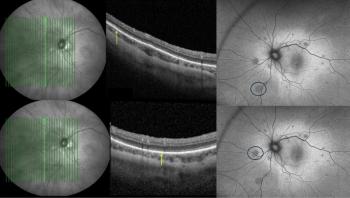
What therapy should we be administering to our DME patients? STEROIDS
Until I see research to convince me otherwise, steroid therapy will continue to be my drug of choice.
Key Points
Intravitreal steroids are my drug therapy of choice when choosing between steroid and anti-VEGF therapy for my diabetic macular oedema (DME) patients.
Deciding on an appropriate course of action is, however, not easy in this patient population; a number of factors need to be taken into account, primarily the classification of the ME.
We have several treatment options available to us and as such, my first approach is to understand the nature of the disease before deciding on the best intervention. For example, in DME that is characterized by blood retina barrier breakdown with absence of any traction on OCT, laser photocoagulation is the best treatment option. Meanwhile, cases that do not show strict relationships between vascular abnormalities and retina thickness might benefit from surgery (around 10% of my patients).
In all other patients, where there is evidence of diffuse oedema and extensive retinal thickness, therapeutic intervention should be considered. Steroid therapy is my treatment of choice in this instance. I obtain more homogeneous results, a good reduction in retinal thickness and an improved macular profile in patients that I treat with intravitreal triamcinolone acetonide (IVTA).
Admittedly, IVTA does have a high side effect profile, particularly after five years' administration. Hence I try to limit its use by combining it with laser therapy. I administer IVTA for one to two weeks before laser treatment to reduce overall retinal thickness and then apply laser photocoagulation therapy. These two modalities administered in combination yield improved results. Currently, many of my patients (30–40%) respond well to this approach.
Patients do not respond well enough to anti-VEGF
With regards to the second therapeutic option, anti-VEGF therapy, I have to say that, in my hands, many of my patients appear to be unresponsive to this mode of treatment; around 50% of patients show some sensitivity to anti-VEGF therapy whilst the remaining 50% are totally unresponsive. I find it difficult to understand why this is the case. In those patients who do receive anti-VEGF therapy, once again I administer it in conjunction with laser therapy to enhance the effect. Overall, I do not believe that anti-VEGF is as efficacious as IVTA in treating DME.
Admittedly, anti-VEGF therapy does offer one advantage over steroid therapy and that is the low incidence of side effects; glaucoma and cataract are not side effects associated with VEGF inhibition, for example. However, a recent study has indicated that caution should still be taken with these agents, when VEGF inhibition was found to be associated with photoreceptor and Müller glia cell death.1
The problem we still have today lies in the classification of DME patients. We still do not know which patients will respond well to steroid treatment and which will benefit more from anti-VEGF therapy. An improvement in our diagnostic capabilities and our ability to assign the most appropriate course of treatment will mark a huge step forward in the treatment of DME. It is imperative that we continue to improve our understanding of the disease and its intervention.
Until we further our understanding, it is my belief that IVTA is more efficacious than anti-VEGF therapy in the treatment of DME and, until I see research to convince me otherwise, steroid therapy will continue to be my drug therapy of choice for this group of patients.
Lack of availability a problem
In Italy, however, we are currently facing some real problems with gaining access to IVTA. For some reason that is unknown to me, our most commonly administered IVTA (Kenacort; Bristol-Myers Squibb) is now unavailable to us. Last year, the drug's manufacturers altered the label stating that intravitreal administration of the agent was against label and, as such, should not be used for ocular injection. This has created a big problem in Italy. Continued use of the agent would have serious legal implications, hence we are forced to use generic triamcinolone.
While we await the launch of new steroid formulations from Allergan and Alcon, this will continue to pose a problem for us.
Moving forward, I do not believe that surgery will feature as a treatment option in the future. Rather, I feel that the future of DME treatment will lie in the combination of drug therapies.
---
To read Professor Jose Cunha-Vaz's counter-argument, please go to
---
References
1. M. Saint-Geniez, et al. PLoS ONE 2008; 3(11): e3554.
Newsletter
Get the essential updates shaping the future of pharma manufacturing and compliance—subscribe today to Pharmaceutical Technology and never miss a breakthrough.













































